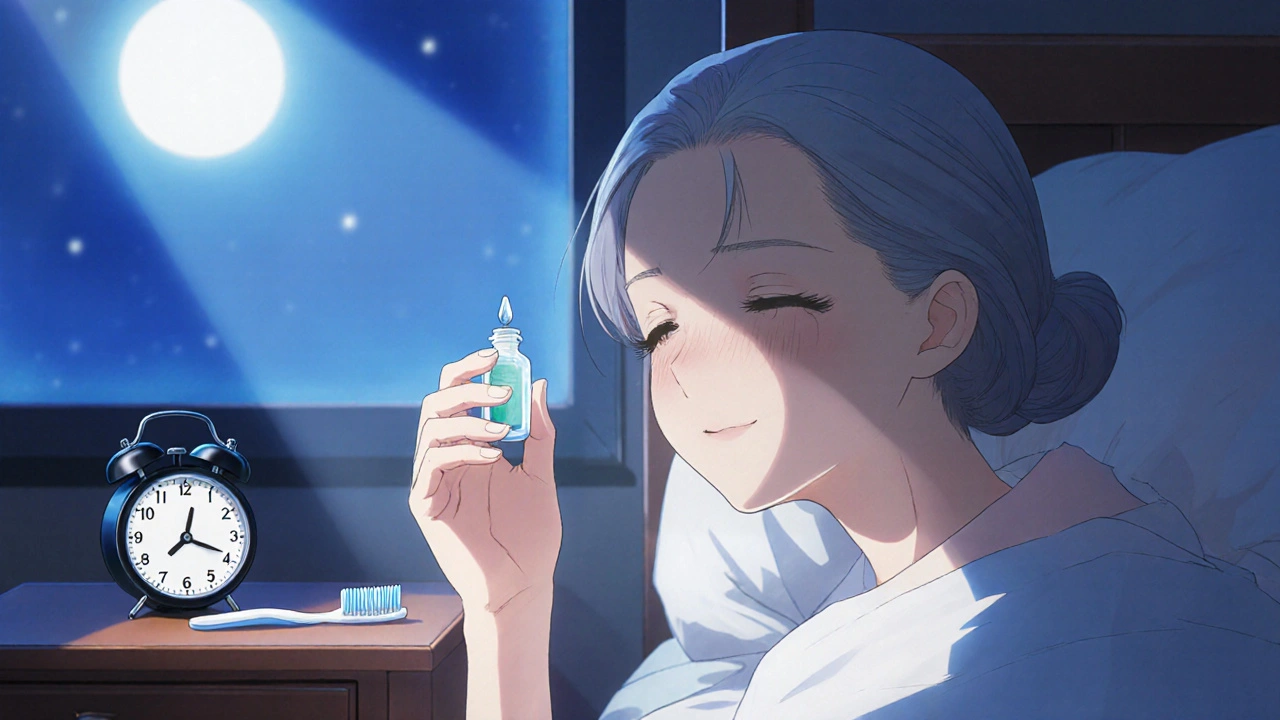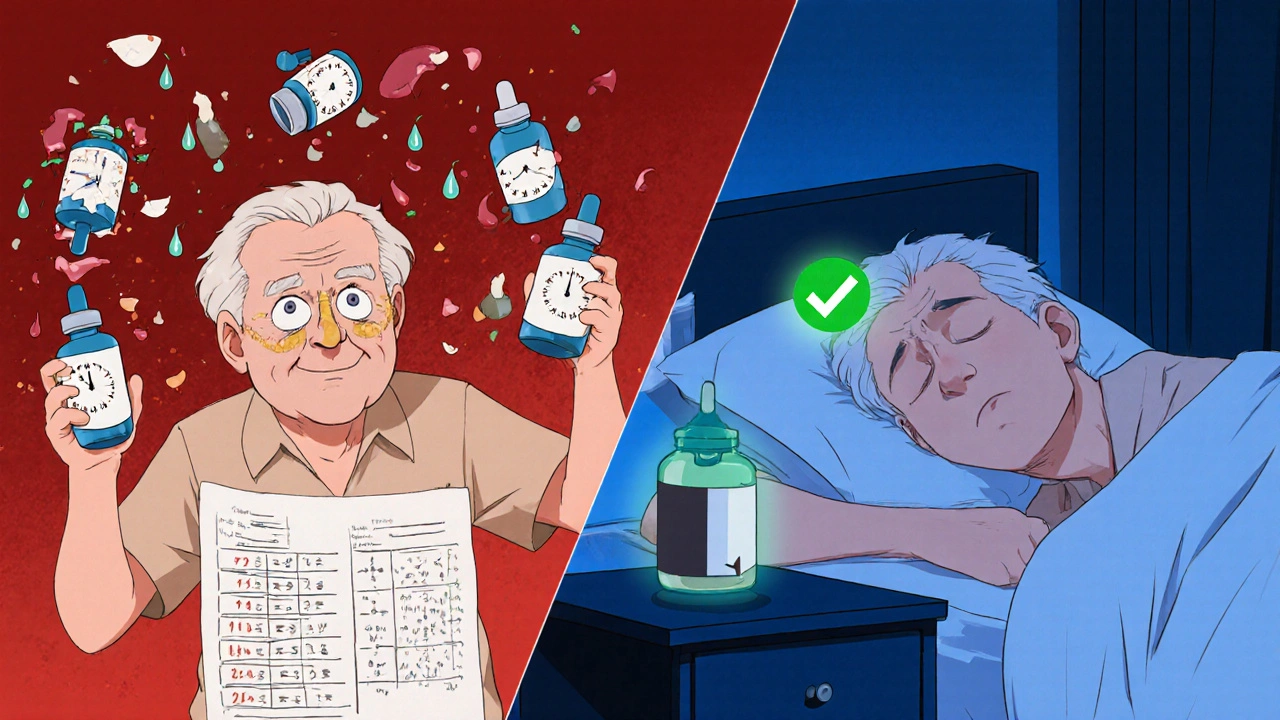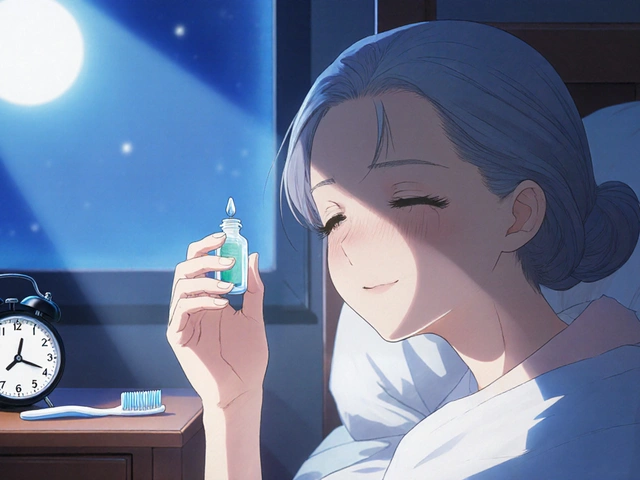
Glaucoma doesn’t care if you forget your pills. It doesn’t pause its damage because you’re busy, tired, or confused. Left untreated, it slowly steals your vision-often without warning. And here’s the harsh truth: nearly half of all glaucoma patients stop taking their medication within a year. That’s not because they don’t care. It’s because most eye drops are a hassle. But latanoprost changed that.
Why Glaucoma Patients Stop Taking Their Meds
Glaucoma treatment usually means daily eye drops. For life. That’s not a quick fix-it’s a lifestyle shift. Many patients are older. Some have arthritis, shaky hands, or memory issues. Others get overwhelmed by multiple medications. A typical regimen might include three different drops, each with its own timing: morning, afternoon, night. Some need to wait 5 minutes between each one. It’s easy to see why people give up.
One 2023 study tracking over 1,200 glaucoma patients found that 47% stopped their drops by the 12-month mark. The biggest reasons? Too many drops per day, complicated instructions, and side effects like red eyes or eyelash growth. These aren’t minor complaints-they’re deal-breakers.
What Makes Latanoprost Different
Latanoprost isn’t just another eye drop. It’s a prostaglandin analog that works differently than older drugs. Instead of reducing fluid production in the eye, it helps drain excess fluid through the uveoscleral pathway. That means one simple rule: one drop, once a day, at bedtime.
That’s it. No morning. No afternoon. No waiting. No mixing. Just one drop before you sleep. This simplicity is why doctors now recommend latanoprost as a first-line treatment for open-angle glaucoma. The American Academy of Ophthalmology lists it as a preferred option in their clinical guidelines. And it’s not just theory-real-world data backs it up.
A 2024 meta-analysis of 15 clinical trials showed that patients on latanoprost were 38% more likely to stick with their treatment after 12 months compared to those on older drops like timolol or dorzolamide. Why? Because it’s easier. Less steps. Less confusion. Less guilt when you miss a dose.
How Latanoprost Reduces Side Effects
Older glaucoma drops often caused burning, stinging, or blurred vision right after application. That discomfort made people skip doses. Latanoprost doesn’t eliminate side effects entirely, but it minimizes them. Most users report mild irritation at worst-and that fades within a few days.
There’s one noticeable side effect: eyelashes grow longer and darker. Some patients even notice their irises getting darker over time. These changes are permanent, but they’re not dangerous. In fact, many patients don’t mind them. Some even say they like the fuller lashes. That’s not a bug-it’s a feature that reduces psychological resistance to treatment.
When patients don’t feel punished by their medicine, they’re more likely to keep using it. Latanoprost doesn’t just lower eye pressure. It lowers the emotional cost of treatment.

Real Results: Lower Pressure, Better Outcomes
Latanoprost doesn’t just make life easier-it works better. On average, it lowers intraocular pressure (IOP) by 25% to 33%. That’s stronger than timolol, the old standard. In some patients, it drops pressure as much as 40%. That’s the difference between slow vision loss and stable sight for decades.
One patient in Minneapolis, 68-year-old Carol Ruiz, started latanoprost after her IOP jumped to 28 mmHg. She was on two other drops and kept forgetting one. Within two weeks of switching, her pressure dropped to 16. She didn’t have to remember anything except putting the drop in before bed. “I didn’t even think about it anymore,” she said. “It just became part of my routine.”
Her case isn’t rare. A 2025 study from the University of Minnesota Eye Clinic followed 300 patients on latanoprost for two years. Only 18% discontinued use. That’s the lowest dropout rate ever recorded for glaucoma monotherapy.
Why Simplicity Wins in Chronic Care
Chronic diseases like glaucoma aren’t won with fancy tech or expensive gadgets. They’re won with consistency. And consistency comes from simplicity.
Think about it: if you had to take five pills every day, you’d probably miss some. But if you only had to take one at the same time every night, it becomes automatic-like brushing your teeth. Latanoprost turns glaucoma treatment from a chore into a habit.
It also helps with cost. Fewer drops mean fewer prescriptions, fewer pharmacy trips, and less waste. Many insurance plans cover latanoprost at low copays. Generic versions are widely available now, making it one of the most affordable options too.
What Happens When Patients Don’t Take Their Drops
Skipping latanoprost-even for a few days-can cause pressure spikes. That’s when nerve damage accelerates. One study showed that just two missed doses in a week increased the risk of visual field loss by 21% over the next year.
And here’s the scary part: patients often don’t realize they’re damaging their vision. Glaucoma doesn’t hurt. You won’t notice the blind spots until it’s too late. That’s why compliance isn’t optional-it’s life-preserving.
Latanoprost doesn’t just treat glaucoma. It protects patients from themselves. By making treatment easier, it reduces the chance of accidental neglect.

How to Use Latanoprost Right
Even the best drug fails if it’s used wrong. Here’s how to get the most out of latanoprost:
- Use it at bedtime. It works best overnight when your eyes are closed.
- Don’t touch the dropper tip. Keep it clean to avoid infection.
- Close your eye for a minute after applying. Press gently on the inner corner of your eye to keep the drop from draining into your nose.
- Wait at least 5 minutes before using any other eye drops-if you need them.
- Store the bottle at room temperature. Once opened, it lasts 6 weeks.
Many patients use reminder apps or link the drop to brushing their teeth. That’s smart. But most don’t need it. The simplicity of once-daily use makes it stick.
When Latanoprost Isn’t Enough
Latanoprost works great for most people-but not all. Some patients need combination therapy. If your pressure doesn’t drop enough, your doctor might add a second drop like brimonidine or a beta-blocker. Or switch to a fixed-dose combo like latanoprost/timolol.
It’s also not used for angle-closure glaucoma or in children under 18. And if you have a history of eye inflammation or certain retinal conditions, your doctor will check carefully before prescribing it.
But for the vast majority with open-angle glaucoma, latanoprost is the gold standard. It’s not perfect. But it’s the closest thing we have to a perfect treatment.
Final Thought: Compliance Is the Real Cure
Glaucoma can’t be cured. But it can be controlled. And control depends on one thing: showing up every day. Latanoprost doesn’t cure glaucoma. But it gives patients a fighting chance-by making the treatment simple, effective, and almost invisible in daily life.
It’s not about magic. It’s about removing barriers. One drop. One time. One less reason to quit.
Does latanoprost cause permanent eye color changes?
Yes, in some patients, latanoprost can cause the iris to darken over months or years, especially in people with hazel or green eyes. This change is permanent but harmless. It happens because the drug increases pigment production in the iris. It’s not a side effect you’ll see right away, and it doesn’t affect vision or eye health.
Can I use latanoprost with contact lenses?
You should remove contact lenses before using latanoprost. Wait at least 15 minutes after applying the drop before putting your lenses back in. The preservative in the solution can get trapped under the lens and irritate your eyes. Most patients find it easier to use the drop at night, right before bed, so contact lenses aren’t an issue.
How long does it take for latanoprost to lower eye pressure?
You’ll start seeing results within 3 to 4 hours after the first dose. The full effect usually kicks in after about a week. Most patients reach their lowest pressure level by 2 to 4 weeks. That’s faster than many older glaucoma medications, which can take up to 6 weeks to stabilize.
Is generic latanoprost as good as the brand name?
Yes. Generic latanoprost contains the exact same active ingredient and meets the same FDA standards as the brand version (Xalatan). Studies show no difference in effectiveness or safety. Many patients switch to generic to save money-sometimes over 80% off the brand price. Just make sure your pharmacy doesn’t switch brands without telling you, as some formulations vary slightly in preservatives.
What if I forget to take my latanoprost drop?
If you forget, put the drop in as soon as you remember-unless it’s almost time for your next dose. Don’t double up. Missing one dose won’t cause sudden damage, but frequent missed doses increase long-term risk. The best strategy is to link it to a daily habit, like brushing your teeth or turning off the lights. Most people find that once it becomes routine, forgetting is rare.
If you’re on latanoprost, keep your follow-up appointments. Your eye doctor will check your pressure and vision regularly. Even if you feel fine, glaucoma doesn’t announce itself. But with latanoprost, you’ve already taken the hardest step-you’re sticking with it. That’s half the battle won.



Latanoprost is a game-changer. I’ve seen patients go from forgetting drops every other day to never missing one-just because it’s bedtime and they’re already brushing their teeth. No alarms, no charts, no guilt. It’s not magic, it’s design. When you remove friction from healthcare, people stick with it. That’s the real win.
I’ve been on this stuff for three years. My lashes are wild now-like I’m auditioning for a mascara commercial. At first I was weirded out, but now? Kinda love it. Feels like my eyes are getting a bonus upgrade. And honestly, I’d take longer lashes over going blind any day.
There’s a deeper philosophical truth here: medicine often fails not because it doesn’t work, but because it demands too much of human frailty. Latanoprost doesn’t ask for discipline-it invites habit. It doesn’t shame you for forgetting; it simply makes forgetting irrelevant. That’s not just pharmacology. That’s humility in design.
They say it’s cheaper but it’s still Big Pharma manipulating us. You think they really care about your vision? Nah. They just found a way to make you dependent on a drop that gives you creepy eyelashes and dark irises. And now everyone’s parroting ‘simplicity wins’ like it’s some miracle. Wake up.
Darkening irises? That’s not a side effect-that’s a government mind control experiment disguised as glaucoma treatment. They want us to look different so we stop recognizing each other. You think your neighbor’s eyes changed naturally? Think again. This is chemical reprogramming under the guise of healthcare. They’re already watching you.
Look, I’ve been a nurse for 22 years and I’ve seen every glaucoma drug under the sun. Timolol? Painful. Dorzolamide? Makes people feel like they’re on acid. Latanoprost? It’s the quiet hero. One drop. One time. No drama. Patients who used to cry in the clinic because they couldn’t handle the regimen now smile because they finally feel like they’re not fighting their own body. That’s not just efficacy-that’s dignity.
Of course it works better-it’s Western medicine. In India we have Ayurvedic drops made from neem and turmeric that have been used for centuries. But no, you all want your plastic bottles and corporate-approved formulas. Why? Because convenience trumps tradition. And now you’re proud of being lazy. Sad.
It is, however, imperative to note that the aforementioned meta-analysis referenced possesses a margin of error within the 95% confidence interval, and the sample size, while statistically adequate, does not account for socioeconomic variables such as access to pharmacy services or digital literacy in medication adherence. Furthermore, the term ‘gold standard’ is semantically imprecise in clinical nomenclature.
my dr switched me to generic and now my eye burns like hell. theyre all the same right? yeah right. i think theyre just trying to save money and dont care if we go blind. also why do i have to wait 5 mins? who made that rule anyway?
One of the most beautiful things about latanoprost is how it levels the playing field. It doesn’t matter if you’re 70 with arthritis, or 55 with ADHD, or just plain overwhelmed by life-it fits into the cracks of your day. No complex schedules. No confusing instructions. It doesn’t demand perfection. It just asks for presence. And in chronic illness, that’s revolutionary. I’ve watched people who gave up on treatment for years come back-not because they were scolded, but because they finally felt like they could succeed.
They say it’s safe but they never tell you about the real risk-what if your eyes change color and then you can’t get life insurance? Or what if your kid inherits darker eyes and gets bullied? And why is this only available in the US? Because they want you to be dependent on their system. The FDA approved this because Big Pharma paid them. Wake up people. This isn’t medicine. It’s a trap disguised as help.